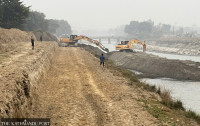National
Local governments must take its advice on roads, Department of Roads says
Unnecessary and haphazard feeder roads destroy natural drainage, and trigger landslides, experts say.
Prithvi Man Shrestha
Nine members of a single family died at Tamadi area of Waling Municipality in Syangja on Thursday as landslides coming from a newly widened road just above buried the house.
“One of the reasons behind the landslide in the area could be the widening of the road just above the buried house although incessant rainfall has caused landslides even in places where there is no fresh road construction,” said Ganga Bahadur Chhetri, the chief district officer in Syangja.
A day after the death of nine people, two other nearby houses were also buried in another bigger landslide early Friday morning. A disaster was averted by evacuating the families from the two houses, said Chhetri.
According to Chhetri, as many as 366 families in around a dozen settlements in the district are in urgent need of resettlement due to landslides either below or above these settlements.
While risk to the human settlements is apparent from haphazard construction of connecting roads, the national highways have also become victims of such constructions.
Incessant rainfall across the country in the last few days caused several landslides on the Prithvi Highway, one of the busiest national highways where over 8,000 vehicles ply in a day in normal times.
Krishna Raj Adhikari, chief of the Road Division, Bharatpur, said the road was blocked at 50 to 60 places due to landslides caused by the rains in recent days with half a dozen major landslides along the Naubise-Narayangadh section. The highway was blocked at several locations due to over 150 landslides in July too, according to the Department of Roads.
“One of the main reasons behind the landslides on the highway is haphazard construction of feeder roads linking it,” said Adhikari.
Officials and experts say that construction of feeder roads destroyed the natural drainage system which is scattered for the land to withstand.
“What feeder roads did is connect the numerous natural drains spreading over wider geography which were stable into one, leading to increased flow of water on the newly constructed roads and this caused landslides,” said Madhukar Upadhya, an expert on watershed management.
Even before feeder roads were constructed rapidly, the country saw landslides. “But frequency and number of landslides have increased manifold as the roads were constructed in a haphazard manner by cutting both rockey and fragile slopes in equal measures without considering the geological condition of the area,” said Upadhya.
As a result, landslides have emerged as a major threat to the several settlements as well to the national highways.
“Landslides occurred at a number of places including Kurintar, Jogimara and Ichchhakamana areas of the Prithvi Highway due to connecting roads above the highway,” said Adhikari.
Not only Prithvi Highway, other highways too are victims of landslides caused by haphazard construction of feeder roads. Incessant rainfall in the last few days caused around two dozen landslides along the Kanti Highway.
“The landslides that occured at Thapeli area of Bagmati Rural Municipality in Lalitpur and several locations of Makawanpur district along the highway are due to haphazard road construction,” said Dipesh Rajak, a focal person at Kanti Highway Project, which connects Kathmandu with Hetauda.
“Geological condition along the road itself is weak and the haphazard road construction has weakened it further.”
Provincial and local governments are at the forefront of constructing connecting roads. The Public Road Act (1974) necessitates approval from the Department of Roads for constructing auxiliary roads linking the national highways. As per Section 19 of the Act, no person shall build an access road joined to the public road without permission from the department.
But the law has rarely been followed as the local governments, which are heavily empowered under the new constitution, seek to develop new roads to deliver development.
“We have been sending letters to the local administrations and the local governments to follow the law,” Rajak said.
The Bharatpur Road Division also said it has written to all local governments along the Prithvi Highway, urging them to follow the law and reminding them about the dangers of haphazard construction of such roads.
However, officer bearers of the local governments say they face strong pressure to connect every village with a road network.
“We face pressure to connect even a single house with a road network. Once a road is constructed, landslides cause much damage and we face the blame of causing the landslides,” said Hom Narayan Shrestha, president of the National Association of Rural Municipalities.
The landslide at Jugal Rural Municipality-2 in Sindhupalchok in mid-August had killed 37 people while two are still missing. Shrestha, who is also the chairperson of the rural municipality, said builing road without conducting initial environmental assessment and drainage has resulted in landslides.
“There is demand for road network but the budget is limited. So building roads with the drainage has not got priority,” he said.
“Now, people are increasingly realising that good roads should be built even if road networks could not be increased as targeted.”
In the past, a concept of green road was introduced where people constructed the road without using machines in hilly regions. “People used to build one lane in the first year, second lane in the second year and third lane in the next year. This could reduce the chance of landslides,” said Upadhya.
“Now there is an increased focus on the use of excavators. Even on the roads where the use of escavators have been prohibited, they are being used. Many politicians at the local level own excavators and they want to reap benefits.”
Service delivery and trade also get affected if landslides continue to obstruct the road. In particular, Nepal-China trade is often obstructed due to landslides that occur on the roads connecting Rasuwagadhi and Tatopani border points.




 9.12°C Kathmandu
9.12°C Kathmandu















